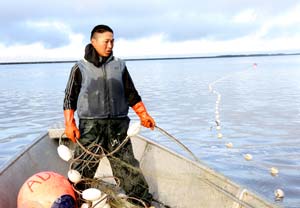SUSTAINABILITY – AN INTERNATIONAL EFFORT
Involving the Cooperation of Many Stakeholders
The Yukon River drains approximately 220,000 square miles in Alaska and 110,000 square miles in Canada, making the entire drainage larger than the state of Texas. Because significant numbers of salmon are produced on both sides of the border, managing the valuable Yukon River salmon resource is a complex international effort, involving the close cooperation of all stakeholders involved in the fishery from both the United States and Canada.
Today, it is fair to say that all management efforts related to the Yukon River salmon fishery are focused on one important sustainability goal: To allow enough fish to escape to their spawning grounds to ensure that there will be fish in the future for both subsistence and commercial users all along the river.
To provide guidance to all parties, in 2002—after 16 years of negotiations—the United States and Canada entered into an agreement, under the Pacific Salmon Treaty (PST), known as the Yukon Salmon Agreement. This Agreement outlines both parties’ commitment to the restoration, conservation, and management of the salmon upon which Yukon River communities depend.
Additionally, the Agreement obligates both countries to manage their salmon fisheries in a way that allows enough spawning salmon to escape harvest, and to follow agreed-upon harvest-sharing arrangements. Further, the Agreement recognizes that the subsistence fishery in Alaska and First Nations fisheries in Canada have priority over other fisheries in each respective country.
Setting escapement goals and making other management recommendations is the responsibility of the Yukon River Panel (YRP). Established by the PST between the United States and Canada, the YRP not only sets escapement goals for Canadian-origin salmon but also makes recommendations to the management entities on both sides of the border that have oversight of the salmon stocks originating in Canada. The Alaska Department of Fish and Game (ADF&G) serves that management function in the United States; in Canada, that responsibility falls to the Department of Fisheries and Oceans (DFO). Both are responsible for any agreements between the countries regarding Canadian-origin Yukon River salmon.
In addition to Yukon Salmon Agreement and YRP recommendations, Alaska’s salmon fisheries are subject to the policies and regulations set forth by the State of Alaska. The primary policy-setting entity for the state’s fishery resource is the Alaska Board of Fisheries (BOF). With input from the BOF Advisory Committees (AC) and the public, the BOF not only sets policy but also establishes regulations and sets the overall direction for the management of the state’s fishery resources. ADF&G then manages these fisheries based on the BOF’s decisions.
In Alaska, the 220,000 square miles of the Yukon River drainage includes 1,200 miles of the mainstem Yukon River, major Alaskan tributary rivers, such as the Koyukuk, Tanana and Porcupine Rivers, and various other smaller tributary streams. ADF&G manages all subsistence, commercial, sport, and personal use fisheries within the Alaskan portion of the Yukon River drainage.
In federal public waters, however, subsistence is managed jointly by ADF&G and the U.S. Fish and Wildlife Service. The Federal Subsistence Board (FSB), with input from the Federal Subsistence Regional Advisory Councils (RAC) and in consultations with the federally-recognized tribes, has regulatory responsibility for subsistence fisheries on federal public waters for federally-qualified subsistence users. In addition, the Canadian DFO regulates and manages all Yukon River salmon fisheries within the Canadian portion of the Yukon River drainage.
As a key stakeholder in the Yukon River salmon fishery, Kwik’pak Fisheries is an active participant in the state and federal fishery processes that set policy and direction for the fisheries and also participates in various other fishery advisory and informational meetings. These include the State of Alaska BOF process, FSB process, YRP meetings, BOF AC meetings, RAC meetings, ADF&G Interagency staff meetings, and Yukon River Drainage Fisheries Association-hosted fishermen’s meetings. Kwik’pak Fisheries also serves on the Alaska Seafood Marketing Institute’s Board of Directors. Additionally, Kwik’pak Fisheries has supported, and continues to support, salmon research projects in Alaska and Canada.



